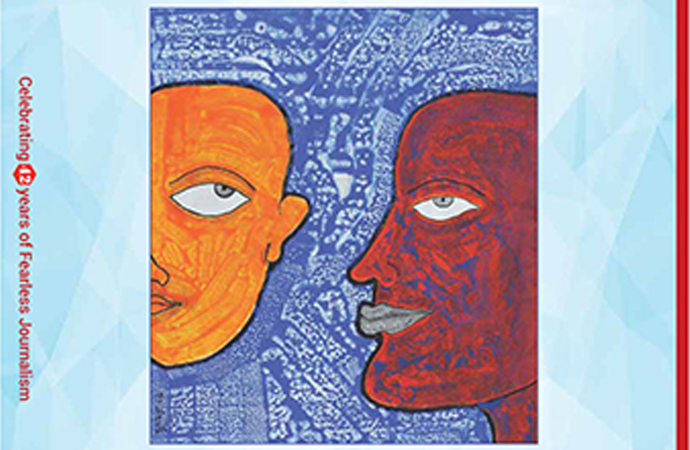Column

A week or so back I posted on Facebook that I wanted to cook chicken with ripe watermelon. It was after I had actually bought a tormuz and was planning to cook chicken. The main consumer is my daughter and dad-cooks like us work extra hard to please children, as they lack historical experience and hence confidence. That's another matter.
Nevertheless as I waited for the chicken to unfreeze I posted asking how it would be. As a regular Facebooker I have some idea what is enjoyed by more people and which aren't. This post I thought was a flaky sort, passing entertainment which would disappear into the digital black hole like so many others.
Not only did it not disappear, it went I suppose you could say viral, almost gathering as many comments as emojis. But the comments stood out. As I read and responded- bad habit- I realized that I wasn't dealing with a typical response to a "silly" post/comment but probably getting a peep into the Bangali soul, the Bangladeshi heart that beats on with both pride and anxiety. Anything more?
Two other issues emerged. One was my staple favourite - deep-baked bread which to my FB friends is burnt bread or "Pora rooti." The other part was even more interesting. Most said the pioneer of all this deviant cooking was 'Kekappa', or Keka Ferousi, the Channel I cooking show icon. She had introduced noodles to many of her traditional dishes and remains unforgiven till date.
I was very intrigued by the responses as they kept on coming for long. And I realized that a deep and insecure/iconic part of our soul had been shaken by this simple matter of an unusual recipe. But cultural history wise, what did they all mean?
Food/cooking as social icons
Food is what life sustenance is all about so it's all consuming. Every aspect of human behavior is linked to it. It is not only about staying alive physically but socially as well. This applies to food gathering, preparation and distribution as well. Doing all this requires an entire social process in action, touching everyone.
It's called in very simple terms the food chain and no society can survive by ignoring it. And when food choices are limited including due to supply, this is even more applicable.
A once-insecure society is now understandably deep into food culture. We didn't produce intermediate items to be exchanged for food for a long period but basic ones which were directly consumed. Agro-societies are always about food and its iconization. If food is secure, we are safe and continue to survive. Hence disturbing the food chain including making puts entire societies into risk. So naturally we resist any change. It's part of any peasant culture.
Until the Mughal era when Bengal's agro-revolution began and shifting cultivation entirely disappeared from the plains, people had very little choice despite being a delta. Thus fish consuming was limited to those living near the rivers and maybe occasional fish which was indeed very difficult to obtain. Any food constrained society develops such practices. Middle Eastern societies, pastoral in nature, adopted finger licking, partly to ensure no food is wasted.
Given that scenario, food divisions are clear. Since people had little chance of having protein in Bengal - meat or fish but meat certainly- it's usually cooked as a single item. Vegetables are cooked as a single item and often as the main item in peasant households. Putting vegetable and protein is done only when one can ensure both - festivals- or to avoid cooking a separate dish. Fried fish is a single item and not eaten with vegetables in the same platter with as it's a standalone glorious culinary icon of ours.
Fruits, proteins and Ammu
So where do fruits come into this? Generally, fruits are finishers, eaten at the end in all cultures as desserts and peasants rarely have it. They can hardly afford to mix a desert with the already luxury protein item so putting ripe watermelons -delicious, sweet, etc- with chicken, a rarely eaten protein, would be wasteful and hence to be avoided. Anything that can be saved needs to be so adding both will be a luxury and peasants can't afford that.
But another factor works here in a peasant economy. All such societies are based on the "dhatri" - reproducer- concept and as the settled agriculture hit Bharat, the gods and goddesses also changed status with the emergence of Durga as the prime deity. She is the fertility icon, the producer, the one who brings food to the table. And her human representation is of course the guardian of food - the Mother. Like all societies she is the preparer of food hence the guarantor of sustenance. To deviate from her worship is to risk survival.
Therefore how Ammu cooks becomes iconic /religious ritual. It's not a matter of taste but a sense of security and the sacred. To do otherwise is to be profane and that is a sin. Ammu never used ripe watermelons in any cooking so when we are faced with that suggestion, we are shocked and hit where it matters most, our icons, our sense of security and our sacred space.
It's not an accident that we are a mother -worshipping society where Ammu can do no wrong. And Ammu never cooked chicken this way.
More soon when we discuss Kekappa and burnt rooti, but the basic theme is the same. It's not the ripe watermelon brother Bangus, it's about your Ammu.

























Leave a Comment
Recent Posts
The forensic clean up of the f ...
Much of the coverage centring the surge in Non Performing Loans (NPLs) ...
Hong Kong’s deadliest fire in ...
Hong Kong’s deadliest fire in decades left at least 44 people de ...
False document submission hurts genuine students’ ch ..
The Missing Ingredients for Peace in Palestine
Songs of Hyacinth Boats & Hands: Reading Conversatio ..
Executive Editor Julie Pace on why AP is standing fo ..